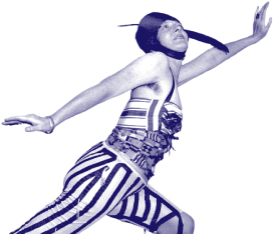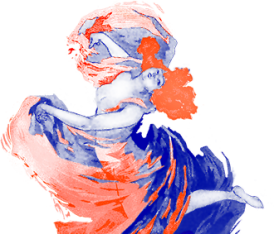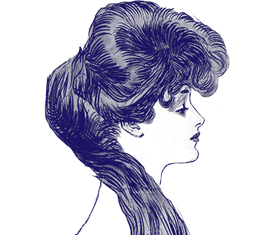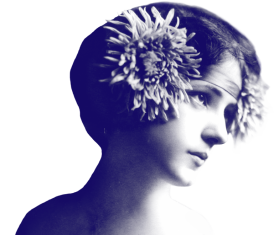HomeNews & Events2003August Baroness Elsa
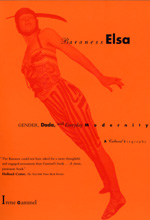
Baroness Elsa
Gender, Dada, and Everyday Modernity
A Cultural Biography
By Irene Gammel
Cambridge: MIT, 2002.
Village Voice: Baroness Elsa selected in the 25 Favorite Books of 2002
Baroness Elsa is the first comprehensive study of the life and work of Baroness Elsa von Freytag-Loringhoven (1874-1927).
New York, 1921. Nude, her head shaved and shellacked red, the woman known as the Baroness flamboyantly flashed her body in the offices of The Little Review, the era's most vanguard (and most feminist) magazine. Caustic and vitriolic, the German war widow, poet, sculptor, and model literally embodied dada in New York (from 1913-1923): stunning her viewers with costumes made of mass-produced items like teaspoons, vegetables, and battery taillights; or sporting a bra made of tomato cans – which she brilliantly declared to be art – all decades before Andy Warhol.
Sensual and organic, her art loudly protested Marcel Duchamp's aesthetics of indifference and was distinctively different from the machine objects of male dadaists. Yearning to teach young America the lessons of modernity, the middle-aged Baroness was the magnetic centre of a Euro/American force field: the living spark plug that propelled America into modernity.
As a language and performance artist, I have the highest respect for the early avant-garde and for dada artists. In Gammel's biography,the Baroness emerges as a truly groundbreaking force.
- Yoko Ono
More on Baroness Elsa
In a remarkable female odyssey through New York, Berlin, Munich, and Paris, this cultural biography captures the Baroness's explosion of sexual conventions in riveting accounts of high-risk sexcapades: three unconventional marriages to renowned artists and a baron; adultery, bigamy, and exhibitionism – all played out against an heroic struggle to make a living with her art. The Baroness cultivated intensely charged friendships with women (D. Barnes, B. Abbott, J. Heap, and M. Anderson); aggressively pursued men (F. P. Greve, M. Duchamp, W. C. Williams, and the Cast-Iron Lover); and compelled the support of high-powered American modernists (P. Guggenheim, E. Pound and E. Hemingway). The fiercely anti-bourgeois figurehead of New York's anti-censorship movement, the Baroness taunted the censor with heavy metal poetry that brimmed with sex and violence and with new word images ("spinsterlollypops" and "celluloid tubes"). Her boxing match with the American poet William Carlos Williams was legendary.
In this groundbreaking cultural biography, Irene Gammel exhibits a wealth of rare archival photographs, attractive art work, and letters documenting the Baroness's sensual beauty and profound influence on her contemporaries. Gammel's theoretically astute lens reconfigures our thinking about central art works of the twentieth century, including Duchamp's "Fountain" and Man Ray's photo and film experiments; and about literary masterpieces of modernism including Nightwood, Ulysses, and The Sun Also Rises that reveal the Baroness's haunting presence. In provocative readings, Baroness Elsa finally expands our conception of the female avantgarde by launching this woman/warrior/artist in her living colours, the most extraordinary figure of her generation (M. Anderson).
Citations and Reviews
Baroness Elsa showed up at the end of the 19th century with her antennae tuned to some distant future and made her life into an anarchic performance. Irene Gammel's biography mounts an enthusiastic case for her as a great unsung modernist, admired by Duchamp, Pound, and Hemingway. The book traces her influence on the avant-garde, posing questions about authorship and modern art.
— Village Voice Literary Supplement, Baroness Elsa was chosen as one of the 25 Favorite Books of 2002.
The Baroness could not have asked for a more thoughtful and engaged monument than Gammel’s book. When Djuna Barnes was struggling in the 1930's to write her biography of the Baroness—she never finished it—a friend advised her to think of Elsa "in as detached a way as you possibly can—not as a saint or a madwoman, but as a woman of genius, alone in the world, frantic.” Gammel has taken that advice to heart, and a dense, passionate book has come from it.
— Holland Cotter, New York Times Book Review
A new biography—"Baroness Elsa” by Irene Gammel—finally establishes Elsa von Freytag-Loringhoven’s rightful place as the first American performance artist. Now that it is practically impossible not to wear mass-produced clothing, encouraging women to hire stylists to make themselves look different, there is enormous appeal in the Baroness’s surreal ensembles.
— René Steinke, New York Times Fashion Magazine
The Baroness [was] a readymade before the fact. One could hardly think of a better prophet of the mass-marketed acting out that characterizes our age than this aristocrat of Dada.
— Howard Halle, TimeOut
Irene Gammel’s hugely enjoyable biography of Baroness Elsa von Freytag-Loringhoven, ‘the mother of Dada,” describes a woman who was both the unrequited lover and inspiration of Marcel Duchamp, and inexhaustibly creative in her own right.
— Modern Painters
Gammel has done a bang-up job of researching Elsa’s spottily documented life, bringing understanding to her unruly art and securing her place on a continuum that leads straight to Hannah Wilke scarring her body with bubble gum and Carolee Schneemann extracting a scroll from her vagina.
— Margot Mifflin, Bookforum
Hailed as America’s Dada queen and the great aunt of contemporary performance art, Elsa von Freytag-Loringhoven is the subject of an exhaustive biography.... Gammel recontructs in fascinating detail the family and artistic environments in which Elsa moved in Europe and America.
— Linda Lappin, The Literary Review
[Irene Gammel’s] fervently argued cultural biography is a seminal work in biography-based Gender Studies. ... The excellently produced volume includes a beautiful set of ninety illustrations, many of them in colour, representing the largest collection of art works by and about the Baroness Elsa so far assembled in a book. For this alone, Gammel deserves thanks and recognition in both the literary and the art community.
— Klaus Martens, Zeitschrift für Kanadastudien
Gammel’s meticulously researched and eloquently written book not only chronicles the view mouvementée of the Baroness herself, but also defines and interconnects the diverse art movements on both sides of, the Atlantic that gave rise to postmodernism.
— Rosmarin Heidenreich, Canadian Literature
Courageous to an insane degree, Elsa was able to provoke and challenge everyone, but has been little known outside the connoisseur’s circle. Irene Gammel, in her fascinating new biography, follows the baroness’ life through the early movements of the 20th century in Berlin, Munich, New York, and Berlin.
— Valery Oisteanu, Artnet
A key figure of New York Dada and an attention-seeking fashionista, the Baroness is being recognized for her bizarre antics as a kind of proto-feminst performance artist, presaging the 1960s actions of Carolee Schneemann, Hannah Wilke and Yayoi Kusama. Irene Gammel’s detailed biography examines the baroness’s wrenching, wildly iconoclastic writings, while filling us in on the sordid, juicy details of her remarkable life.
— Michael Duncan, Art in America
Gammel is particularly good at demonstrating how the Baroness served as a cultural signifier of avant-gardism for American modernists .... Gammel makes an important argument, as well regarding the attribution of Duchamp’s famous upturned urinal, "Fountain,” finding within a constellation of circumstantial evidence a provocative possibility that the baroness had more than a hand in the making of this most controversial of objects. Gammel is a good historian; her research is meticulous and exhaustive. She knows how to look at art, describing effectively its formal actions and and cultural significations.
— Joshua Weiner, Modernism/Modernity
I have to say that this is the first biography I've read all the way through. It is like a Danielle Steel novel, although probably not as detailed. As a student of art history I thought this was a very interesting take of the New York Dada movement, where the Baroness was the first to do "ready-mades" before Marcel Duchamp. Overall I thought it was wonderfully written, and very interesting.
— Reader from Boston, amazon.com
She was one of the ‘characters, one of the terrors of the district...”, wrote her first biographer Djuna Barnes. ... A new more exhaustive look into the Baroness’s life [comes in] Irene Gammel’s fascinating Baroness Elsa.
— New York
The Baroness is hailed as America’s first assemblage artist by Irene Gammel, author of a new book, "Baroness Elsa: Gender, Dada, and Everyday Modernity” (MIT Press), which this ... exhibition celebrates.
— New York Times
Gammel, intellectually agile and entertaining, concentrates as much on aesthetics and politics as on her subject's flabbergasting life, making a strong case for the baroness' artistic brilliance, crucial yet overlooked influence on such artists as Duchamp, and the injustice of her neglect.
— Booklist
The ongoing feminist refashioning of the dada movement’s history continues in this large, detailed and well-researched book, the first biography of the Baroness Elsa von Freytag-Loringhoven (1874-1927), one of dada’s most daring and prescient figures.
— Publishers Weekly
One of the early innovators of the Dada movement, Elsa von Freytag-Loringhoven a.k.a. the Baroness has remained in relative obscurity until the publication of this biography, the result of intensive research by Gammel (English, Univ. of Prince Edward Island).
— Library Journal
Baroness Elsa makes Vanessa Beecroft’s chorus line of vaginas and Karen Finley’s canned-yam act look downright dull. ... Irene Gammel’s Baroness Elsa mounts an enthusiastic case for her as one of the great unsung modernists.
— Village Voice
From the Book Cover
"An impressively researched biography about the most startling Dada woman personality ever to explode on the avant-garde scene in New York, Philadelphia, Berlin, and Paris, this book offers a new and invaluable perspective on several sides of that scene. The strong odor of scandal, far removed from many watered-down emulations of it, permeates every page. Crossing every erotic boundary, this Dada-gothic phenomenon called the Baroness Elsa von Freytag-Loringhoven lived the heartbreaking existence of a woman more than on the edge.”
— JMary Ann Caws, Distinguished Professor of English, French, and Comparative Literature, Graduate School, City University of New York
"The Baroness cut the most compelling modernist figure. She literally wore New York dada, thus inventing it as a pattern of aesthetic costume to be worn so tight that it was her skin, her self. She was, as Irene Gammel puts it in this remarkable biographical study, an ‘assemblage of paradoxes embodied in one body.’ That the Baroness knew and inspired or inspiringly repelled nearly everyone associated with the rise of modernist practice in New York has been already part of the story, but it has never been so richly detailed. In Gammel's presentation the Baroness emerges as far more than an ingenue. She became a mature, self-conscious, dynamic, artistic force--and remarkably productive in her own right, not despite but because she exhausted herself from the inside out."
— Alan Filreis, Class of 1942 Professor of English, University of Pennsylvania
"Irene Gammel's Baroness Elsa is a thorough and measured rendition of a life that was anything but thorough and measured, and it bears witness not only to the trials and triumphs of a major woman artist but also to a truism that never ceases to astound: that one small shift in historical perspective can yield a completely different (and much more interesting) story than the one we have always been told."
— Shelley Rice, author of Parisian Views and editor of Inverted Odysseys: Maya Deren, Claude Cahun, Cindy Sherman
"In histories of early twentieth-century Euro-American avant-gardism, the Baroness Elsa von Freytag-Loringhoven--poet, visual and performance artist--is often considered a freakish, eccentric, though fascinating personality on its margins. With Irene Gammel's meticulously researched and engaging biography, the Baroness finally takes her rightful place in the avant-garde's core.”
— Naomi Sawelson-Gorse, editor of Women in Dada: Essays on Sex, Gender, and Identity
"Baroness Elsa presents a fascinating framework for Elsa von Freytag-Loringhoven's participation in the constellations of international Dada. Gammel's cultural biography sustains the suspense of a mystery tale, revealing unexpected influences and conceptual interchange between major artists."
— Carolee Schneemann, visual artist, author of Imaging Her Erotics: Essays, Interviews, Projects
"This book is a true discovery. To find the outer limits of avant-garde performance, we need not look forward, but back, for when it comes to boundary breaking and gender crossing, today's artists can find no more daring example than the long lost Baroness Elsa. Thanks to Irene Gammel's own unprecedented study, she is back.”
— Marina Abramovic, artist, Academy of Fine Arts, Braunschweig
"Gammel successfully revivifies the life and work of this maverick feminist, who wrote evocative experimental poetry, constructed vibrant assemblage art, and enacted herself dramatically throughout the streets and salons of New York in the WWI period. She convincingly demonstrates the Baroness's impact as an original artist, poet, and performer of Dada. This book is a must for all scholars of literary modernism and the Dada movement, but is also terrifically entertaining to read.”
— Amelia Jones, Professor, Department of Art History, University of California, Riverside
"Scholars of modernism in its intersections with feminism and anticipations of post-modernism have long been fascinated by the idiosyncratic Baroness Elsa--body artist, multi-lingual poet, and tragic advocate for artistic and sexual freedom. Irene Gammel has written the book that we were waiting for: its exhaustive research, rich detail, and wide-ranging cultural critique place the Baroness in the company of her peers while honoring her uniqueness.”
— Carolyn Burke, author ofBecoming Modern: The Life of Mina Loy and of a forthcoming biography of Lee Miller
"With perfect aim, Gammel lobs the Baroness Elsa like a hand grenade back into the melee over the nature and duration of the avant-garde legacy.”
— Marisa Januzzi Thomas, Columbia University
Reader Responses
"Just a note to say how much I appreciate finding both Baroness Elsa and Body Sweats – I have been tracking the Little Review because of the Ulysses episodes and your work does make me wonder whether LR was under scrutiny because of many of the pieces they published, not just the three Joyce episodes that were confiscated by the Post Office. You intimate that prosecutors were wise not to provide her a stage in public trial by including her works as ‘obscene’ in the indictment – were they that wise? My impression was that the SPV was as clever as a bull in a china shop, and, by the 1920s, in their swansong. At any rate, thanks – your works helped piece in some of the missing elements of the 1917-1921 LR issues."
— James R. Alexander, Professor of Political Science, University of Pittsburgh at Johnstown
Citations
- CM, "Baroness Elsa.” Modern Painters. Summer 2002.
- Holland Cotter, "The Mama of Dada.” New York Times Book Review. May 19, 2002.
- Christina De Stefano, "La baronessa dada.” Elle Italia. March 2003. 186-89.
- Michael Duncan, "Baroness Elsa von Freytag-Loringhoven.” Art in America. April 2003, p. 135.
- Howard Halle, "Red Baroness.” TimeOut. May 23-30, 2002.
- Irene Gammel, "The Baroness and the Poet.” The Globe and Mail, May 25, 2002.
- Rosmarin Heidenreich. "Baroness Elsa.” Canadian Literature. 2003.
- Linda Lappin, "Dada Queen.” The Literary Review. 46.3 (2003): 558-64.
- Klaus Martens, "Baroness Elsa,” Review. Zeitschrift für Kanadastudien 23:2, vol. 43 (2003): 171-173.
- Margot Mifflin, "The Bride Stripped Bare.” Bookforum. Fall 2002.
- Valery Oisteanu, Artnet April 2002.
- Valery Oisteanu, "From Proto to Retro: Surrealism Reinvented.” NY Arts
- Joy Press, "Dada's Mama.” Village Voice. April 24 - 30, 2002.
- René Steinke, "My Heart Belongs to Dada.” New York Times Fashion Magazine. Fall 2002. 192-98.
- Donna Seaman, Booklist
- René Steinke, New York Times Fashion Magazine. August 2002.
- Village Voice Literary Supplement, Joshua Weiner, Baroness Elsa, Review. Modernism/Modernity 10.3 (2003): 582-84.
- Jane Chafin, "Duchamp's Urinal? Maybe Not!” Huffington Post. May 3, 2012.








